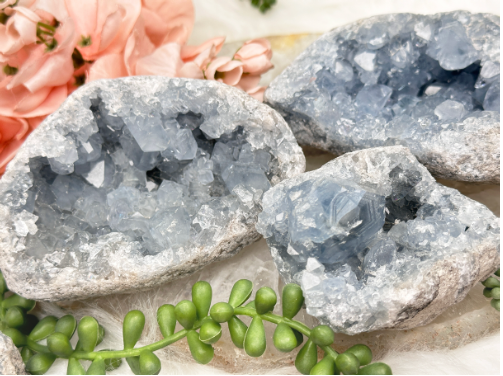Crystals are nature’s exquisite masterpieces, each bearing a unique spectrum of colors that captivates the eye and stirs the soul. From the celestial blue hues of Celestite to the radiant purple of Amethyst and the rosy blush of Rose Quartz, crystals exhibit a dazzling array of colors that seem to defy imagination. But how do these natural wonders acquire their vibrant hues? In this exploration, we delve into the fascinating mechanisms behind the formation of colorful crystals, uncovering the geological processes and chemical compositions that give rise to their breathtaking beauty.
The Role of Trace Elements
One of the key factors influencing the coloration of crystals is the presence of trace elements within their chemical composition. These minute impurities can imbue crystals with a wide range of colors, from subtle tints to vivid hues. For example, the celestial blue color of Celestite is attributed to the presence of trace amounts of strontium within its crystal lattice. Similarly, the greenish-blue tones of Fluorite are believed to result from the presence of trace amounts of yttrium, cerium, or other rare earth elements. By incorporating these trace elements into their molecular structure, crystals are able to manifest a dazzling array of colors that delight the senses and inspire wonder.
The Influence of Crystal Structure
In addition to trace elements, the internal structure of a crystal also plays a crucial role in determining its coloration. Different crystal structures can interact with light in unique ways, resulting in a variety of optical phenomena that give rise to specific colors. For example, the vibrant purple hues of Amethyst are caused by the presence of iron impurities within its crystal lattice, which absorb certain wavelengths of light and transmit others, resulting in the characteristic purple coloration. Similarly, the pink tones of Rose Quartz are thought to be caused by microscopic inclusions of pink minerals such as dumortierite or titanium within its structure, which scatter and reflect light to create a soft, rosy glow.
Mineralogical Alchemy: Crystal Growth and Transformation
The process of crystal growth and transformation is a complex alchemy of geological forces and environmental conditions that can profoundly influence the coloration of crystals. Factors such as temperature, pressure, and the presence of other minerals can all impact the formation and coloration of crystals in unique ways. For example, the green hues of Chrysocolla Aventurine are believed to result from the presence of copper minerals within the surrounding rock matrix, which interact with silica-rich solutions to form the distinctive green veins and patterns characteristic of this stone. Similarly, the warm orange tones of Carnelian are thought to be caused by the presence of iron oxides within the silica-rich solutions from which it crystallizes, imbuing the stone with its vibrant coloration.
Nature’s Palette: Exploring the Diversity of Colorful Crystals
From the celestial blue of Celestite to the fiery red of Carnelian and the soft green of Chalcedony, nature’s palette of colorful crystals is as diverse as it is mesmerizing. Each crystal tells a unique story of geological processes and chemical interactions that have shaped its formation and coloration over millions of years. For example, the delicate pink hues of Rose Quartz are believed to result from the gradual diffusion of iron and titanium into silica-rich solutions, which crystallize to form the characteristic pink quartz crystals. Similarly, the vibrant orange tones of Calcite are thought to be caused by the presence of iron impurities within the crystal lattice, which absorb certain wavelengths of light and transmit others, resulting in the characteristic orange coloration.
The Magic of Crystal Coloration
In conclusion, the vibrant colors of crystals are a testament to the awe-inspiring beauty and complexity of the natural world. From the subtle interplay of trace elements within their chemical composition to the intricate dance of light within their crystal lattice, crystals exhibit a mesmerizing array of colors that stir the imagination and inspire wonder. As we continue to explore the fascinating mechanisms behind the formation of colorful crystals, may we gain a deeper appreciation for the natural processes that shape the world around us and the breathtaking beauty that emerges from their alchemical transformations.




